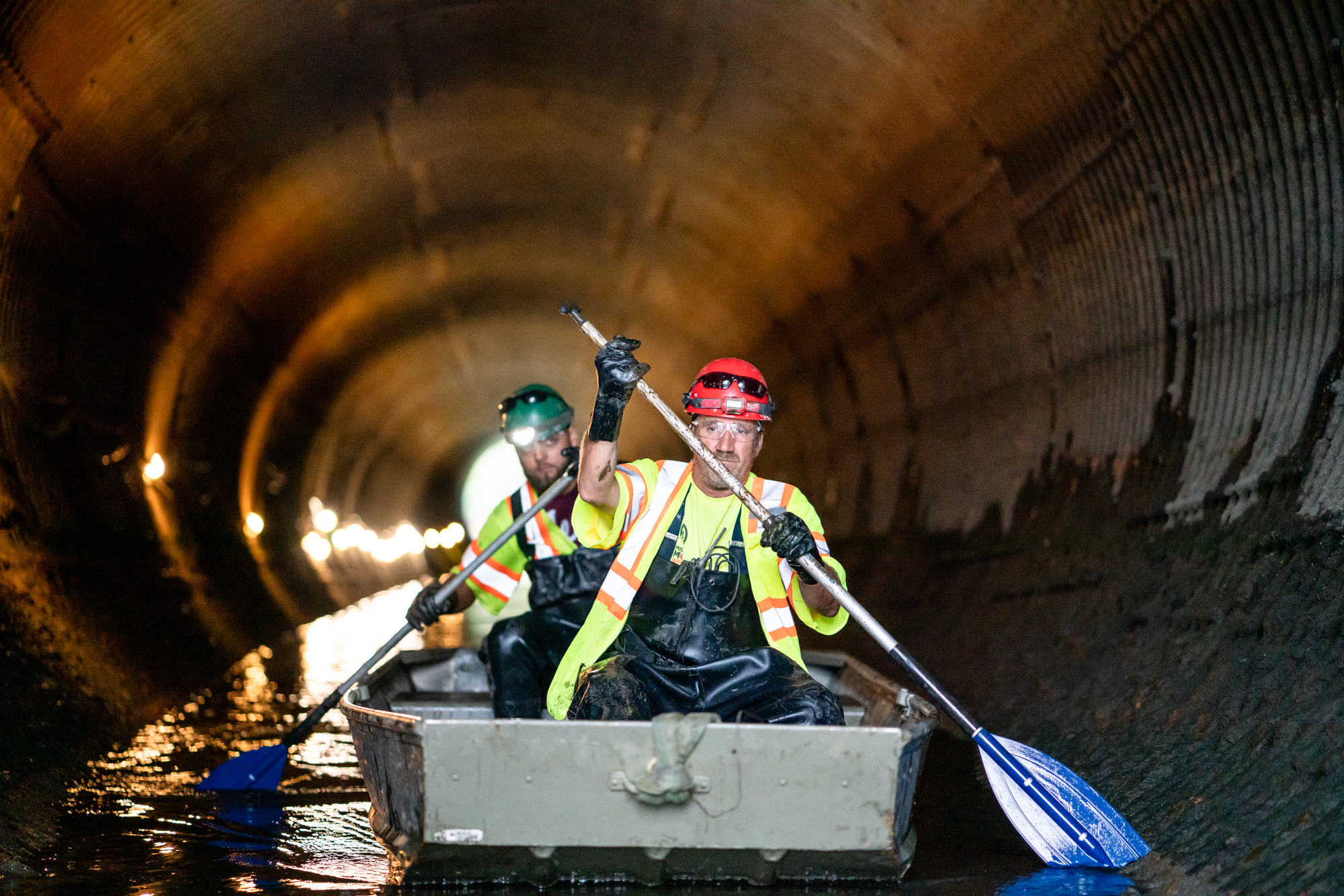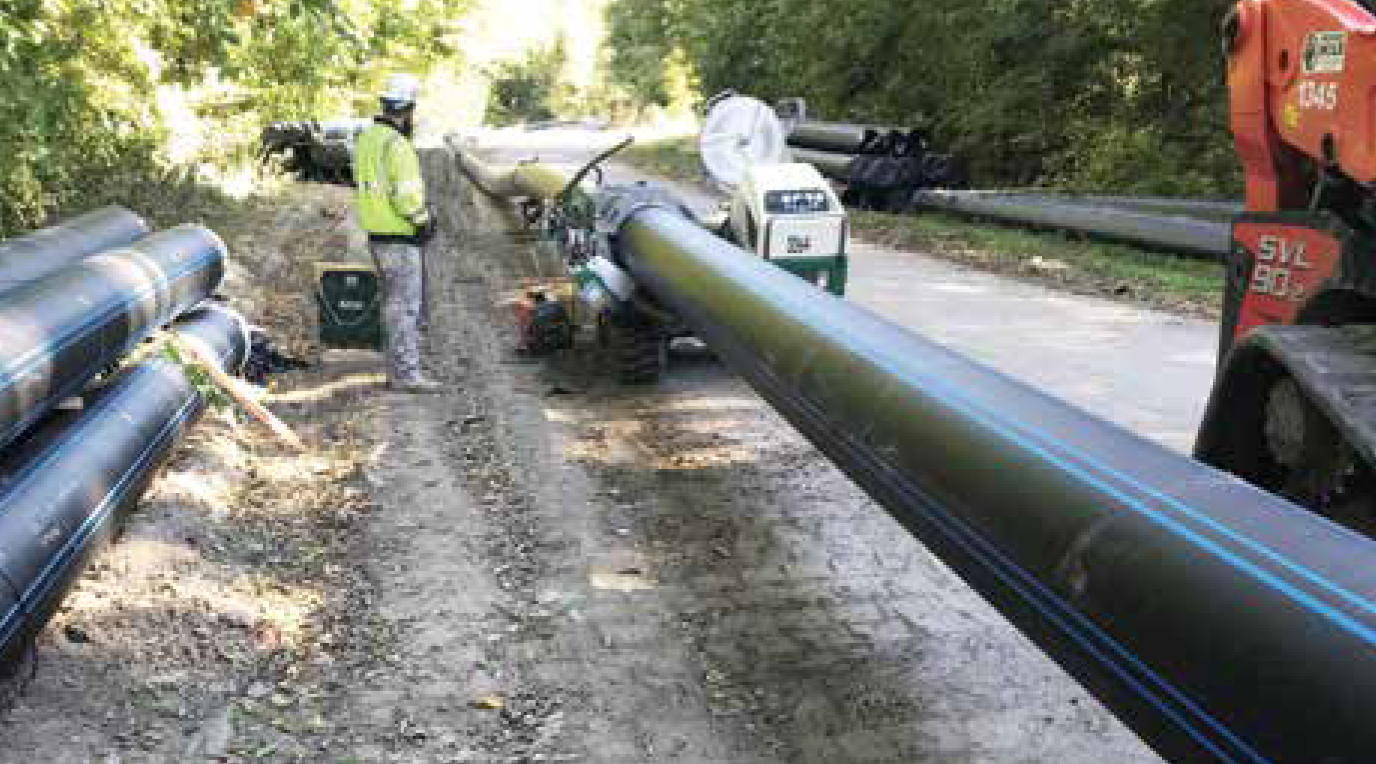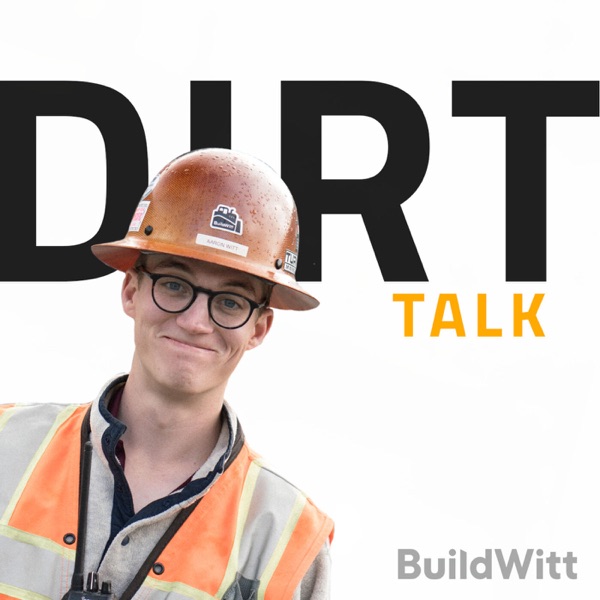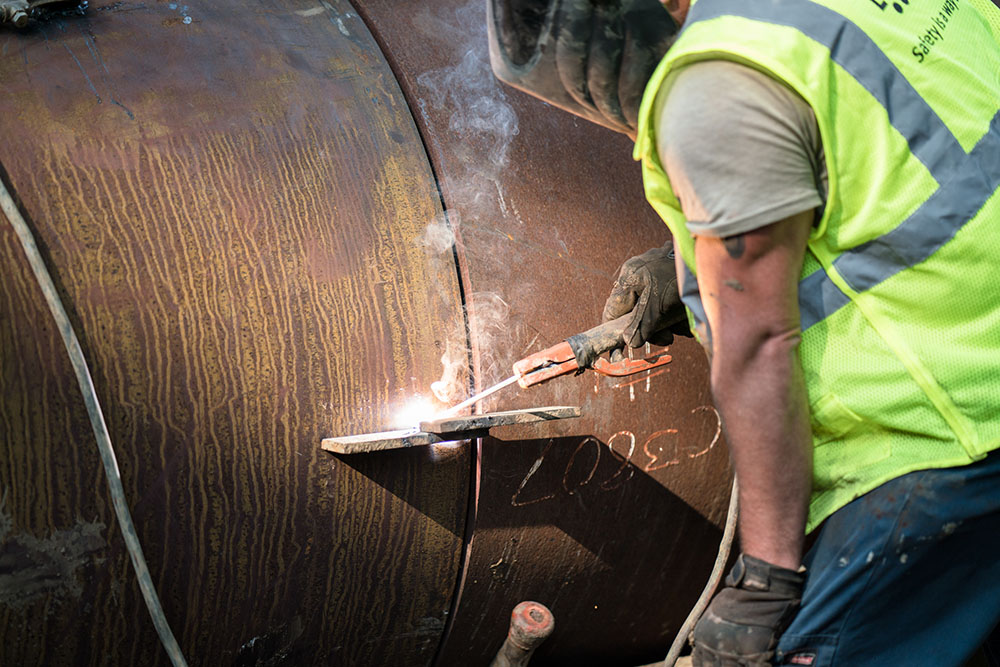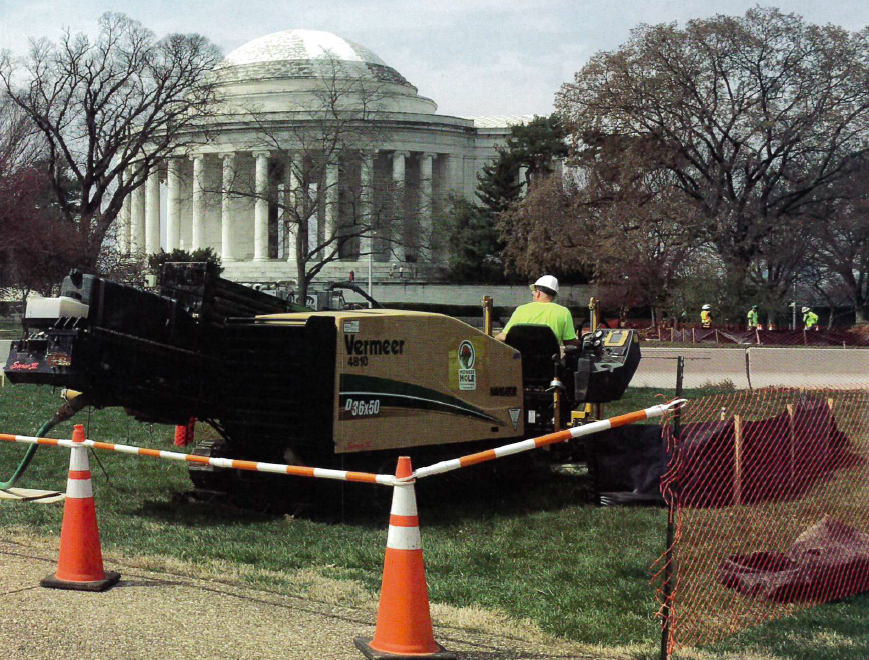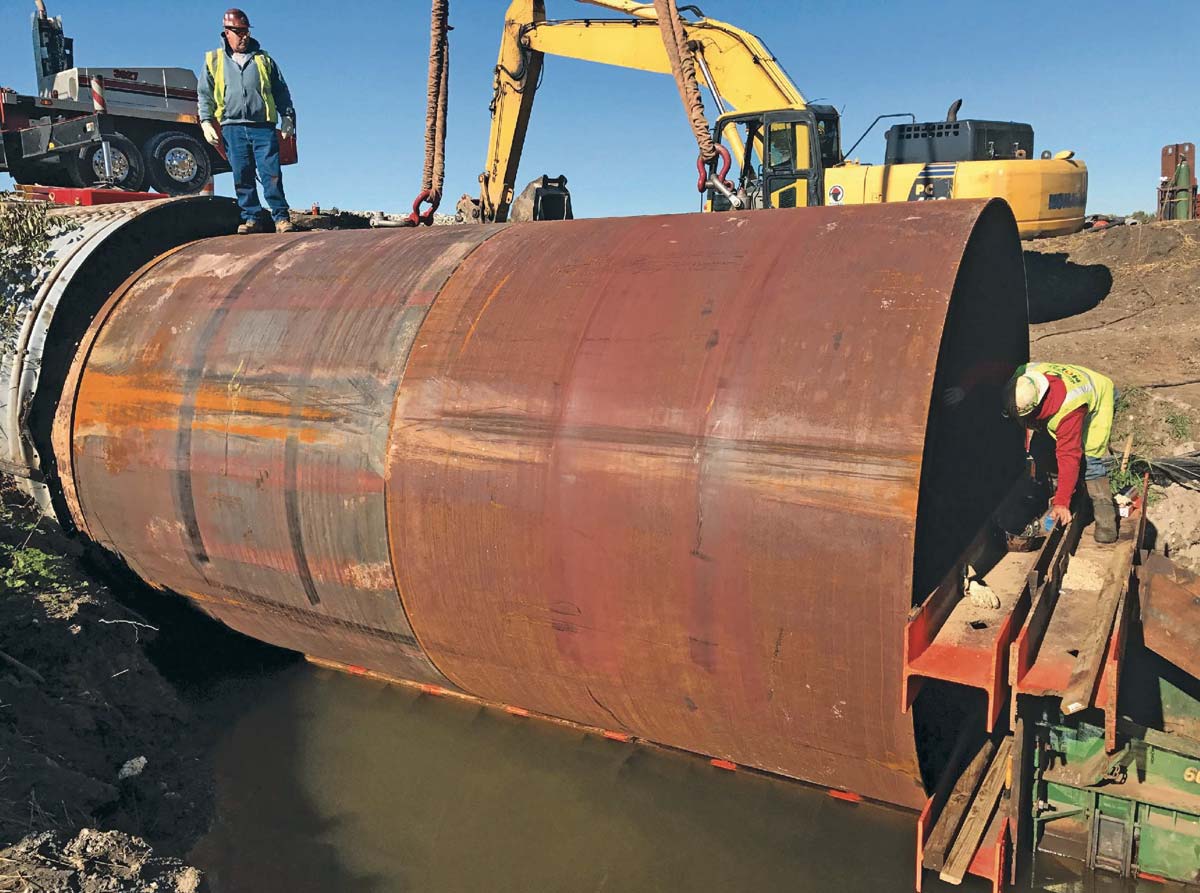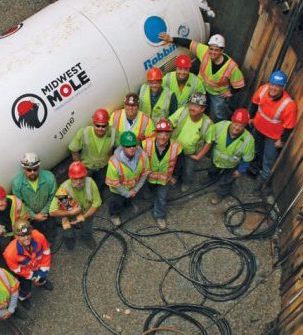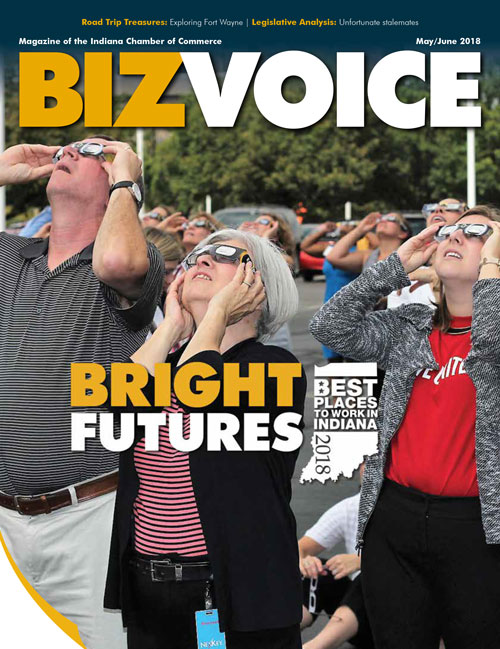INDOT hired Midwest Mole to rehabilitate a failing 14-foot CMP culvert under Interstate 65. The existing CMP had a 2.5-foot belly due to the extreme pressure caused by years of heavy traffic on I-65. Our crews set up a bypass pump to divert the nearby Little Calumet River, dewatered the culvert, installed an 11.5-foot liner, built bulkheads, and filled the annular space with cellular grout. Click to Download Article
Category: News
Under River HDPE Pipe Pull
Midwest Mole crews installed 4,500 feet of 16” HDPE pipe under the Maumee River to connect Fort Wayne’s water supply on the north and south sides of the river. Due to the length of the river crossing, we needed a 1,000-foot bore that crossed under a functioning public trail system and a 48”-diameter reinforced concrete sanitary sewer. MWTA120_Under River HDPE Pipe Pull_32-33
The Mud and the Blood with Jason Miller
Jason Miller, President of Midwest Mole, was the featured guest on Aaron Witt of BuildWitt‘s podcast, Dirt Talk. Read Aaron’s write up of their conversation, with the episode linked below:
Jason Miller is the President of Midwest Mole, an Indiana-based tunneling contractor.
Jason started with Midwest Mole in his teens since his dad was a foreman there at the time. After giving college a shot for a semester, he decided it wasn’t for him, so he dove headfirst into tunneling as a career.
Starting as a laborer, he worked his way through the ranks to the top as an owner while maintaining an extreme sense of humility. He hasn’t forgotten where he started, and he leads the company with that field-first mentality to this day.
We talk about the intricacies of tunneling, what his thoughts are on the next generation, and why their line of work is only for a specific type of person. Digging a cramped tunnel by hand deep underground isn’t for everyone, which is why the Moles at Midwest Mole are so proud of what they do.
Learn more about Midwest Mole at midwestmole.com and follow Jason on LinkedIn at https://www.linkedin.com/in/jasonmiller8/
Midwest Mole Wins Top Job at NUCA Annual Awards
https://www.constructionequipmentguide.com/midwest-mole-wins-top-job-at-nuca-annual-awards/47954
Midwest Mole, an Indiana-based trenchless construction contractor, recently came home with NUCA’s top 2019 trenchless construction job award and the top overall job award for their part in a wild emergency project in Kentucky.
While at the 2018 Kentucky Derby, Jason Miller, president of Midwest Mole, received a call about a potential emergency unfolding in Louisville.
The existing 7 ft. by 7 ft. Ohio River Interceptor (ORI) sewer directly underneath Main Street in downtown Louisville was in danger of collapsing. It had already failed in a few locations, and city officials blocked off sections of Main Street directly above the trunk line. When the mayor drove by and saw the mess in his downtown, he called for immediate action.
Louisville Metro Sewer District (MSD) put together an ace team of experts led by Ulliman Schutte Construction, including Boyer Inc., Midwest Mole and Thompson Pumps, to get the job done by Christmas of that same year.
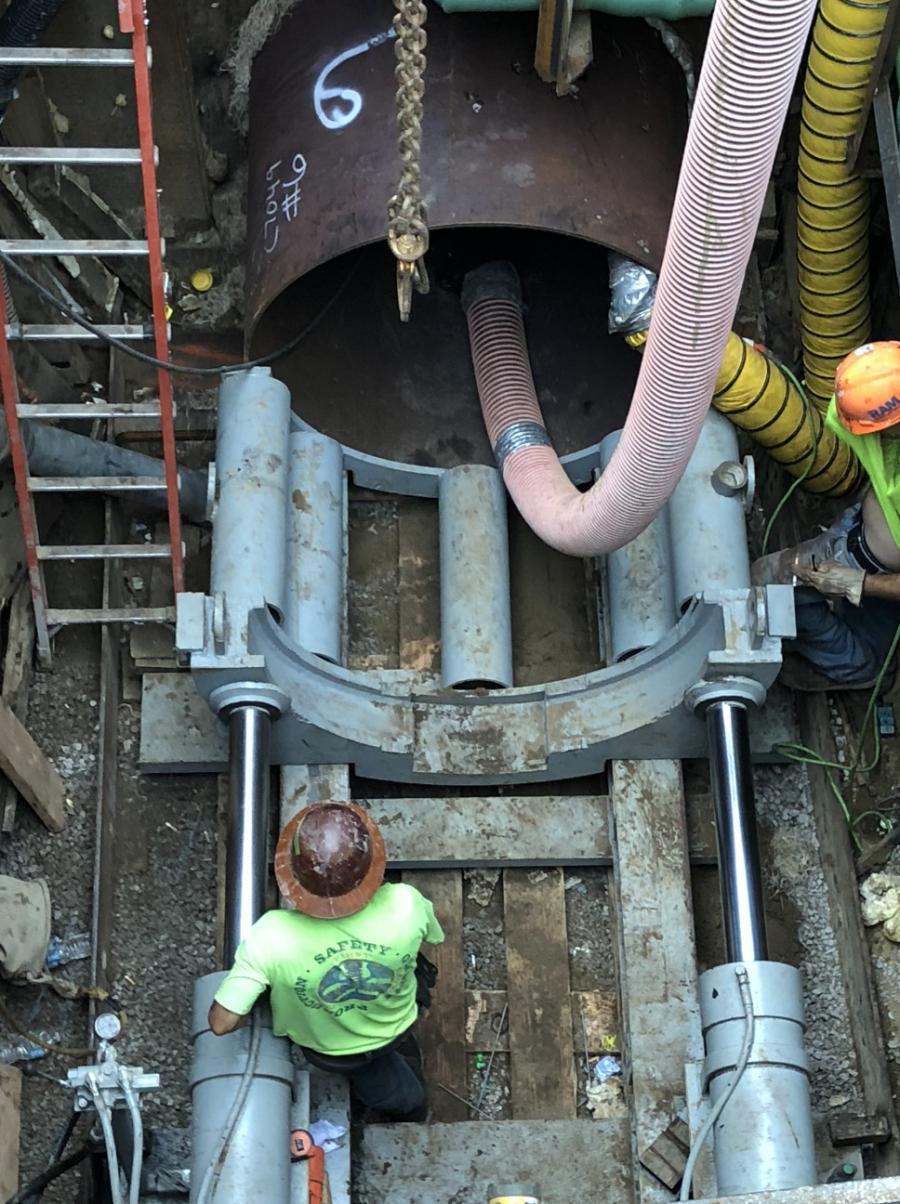
“We put our heads together collectively and started coming up with solutions,” said Jason Miller.
The team found a 2,000-ft. section of the main trunk line that needed rehabilitation with Boyer, Inc. tackling the project using its Danby System. This system works by using a PVC liner as a form while injecting high-strength grout in between the existing tunnel and new liner to create structural strength. During construction, the team also built a bypass to pump 40 million gal. per day.
In addition to the rehab work, there were three combined sewer overflows (CSO’s) located directly underneath Main Street that needed replacing.
According to Miller, “We proposed an idea to put down shafts outside of Main Street and tunnel to the existing ORI sewer.”
Tunneling allowed Midwest Mole to build three new sewers and connect everything underground while Boyer, Inc. was rehabbing the ORI simultaneously.
The reason to eliminate the CSO’s is down to environmental concerns and agreements between cities like Louisville and the federal government. During significant rain events, combined sewer outflows drop sewage into local waterways. To eliminate the environmental and health hazard, Midwest Mole needed to build new sewer lines to split the sanitary sewer from the stormwater sewer.
“It was design-build accelerated times ten,” he said.
After spending more than a month to find three locations for the proposed shafts, Midwest Mole began digging all three with multiple crews starting in May. All shafts were traditional liner plate shafts dug using air spades and mini-excavators.
“One of the shafts was next to the convention center. One side of the box was the sidewalk, and four feet over was the foundation of the convention center,” Miller said.
Another obstacle was a mystery sewer line in the middle of one of the proposed shafts.
Once all shafts were complete, Midwest Mole hand-mined the 54-in. tunnels and jacked steel casing in as they went. Since there was no receiving pit, they couldn’t use an expensive tunneling machine to dig the tunnels.
Before tunneling, the Midwest Mole team did their best to determine where the tunnels needed to be.
“We had to make the best-educated guess collectively. We felt good about it because we had a lot of data, but we couldn’t ensure we were right on it.”
They surveyed the existing tunnel once it was safe to enter, but they couldn’t get exact data without manholes. On top of the survey data, they had two sets of different drawings to reference. Ultimately, they had about 6 in. of wiggle room on each tunnel.
Come December, the construction team finished all substantial parts of the project without closing a single road during the emergency repairs. Midwest Mole has eliminated the CSO’s and Main Street was safe once again.
“We were happy we were part of it. It was a lot of fun,” said Miller.
The residents of Louisville likely have no idea how important this project was for their wellbeing, but that’s the point and wonder of trenchless construction methods.
Midwest Mole came home with NUCA’s top award for this project because of the unique challenges proposed by the location, the timeline, and the scope of work. Additionally, it included multiple types of trenchless construction from rehab to tunneling to bypassing.
“Everyone trusted one another — we knew everyone involved in the project was going to do what they said they were going to do.”
Sliplining in Indiana
A failing culvert was given a second life through trenchless rehabilitation
INFRASTEEL, A PERMANENT CULVERT REHABILITATION SYSTEM, was used by Midwest Mole of Greenfield, Indiana, to slipline a 245-ft long, 144-in. diameter failing corrugated metal pipe (CMP) culvert under US 31 in Miami County, Indiana.
US 31 is a heavily traveled northsouth thoroughfare in Indiana, so the Indiana Department of Transportation determined that sliplining was the best option for repairing the failing structure. The project was bid in the spring of 2017, and construction work was performed in the fall of 2017.
Precision Pipe’s InfraSteel culvert liner is made from smooth wall carbon steel, in custom shapes and sizes specifically for each culvert failure site. InfraSteel has extra copper in the steel for added corrosion resistance and is made in wall thicknesses from ½ to 2 in. thick, which provides superior structural integrity. InfraSteel’s design life is calculated by adding sacrificial steel, for each year of desired life expectancy, to the wall thickness required to handle the existing load bearing requirements. The existing structure for this site was round and reasonably straight, however, it did have a dip in the middle of the run which was taken in consideration when the size was determined. The other major sizing consideration is the hydraulic capacity of the liner. InfraSteel’s Manning’s coefficient is .012, and inlet and outlet control features are available but were not required for this project.
Midwest Mole had to remove approximately 2 ft of silt from the bottom of the existing structure in order to determine what size would fit inside of the host pipe structure. Once the silt was removed, a survey of the line was completed for both elevations and the alignment of the existing pipe. A mandrel built to the OD of the proposed liner was assembled and pulled through the existing pipe prior to final dimensions of the liner being released for fabrication to verify that no issues would arise once the lining commenced. A round liner with an internal dimension of 135 in. was determined to be the best size for this structure. D. H. Charles Engineering’s Cardiff, California, office did the load bearing calculations to determine the wall thickness that would meet HS-20 load bearing requirements, considering the worst case with the tire directly over the top of the culvert for vehicle weight with 5 ft of cover, and on 6 ft of cover for soil weight. A sacrificial loss of .280 in. was added to provide the 70-year life expectancy, based on the culvert being located in an immersed zone with corrosive water. A wall thickness of ¾ in. was determined to be the appropriate wall thickness for this particular project.

When construction was ready to begin, the site had to be prepared. “We were working in a creek, so we had to set up a bypass pumping system that allowed us to work in the dry during the majority of the installation. Stormwater control was a critical component of the project that took a lot of time, handling pumps and piping too reroute flows as needed on the creek” says Midwest Mole senior project manager David Howell.
“We were fortunate too that we had a big enough shoulder to set a crane up on the shoulder area and limit traffic disruption,” he added.
Also, because this was a sliplining project, there was no need to detour traffic off of US 31. There are multiple residences and businesses with access either off of US 31 or from frontage roads which would be affected by detours. This project also coincided with other paving work being done nearby on US 31 that would have caused additional delays or complications in getting both projects completed in a timely manner if road closures or detours would have been required for this work. Road closures and detours are some of the greatest costs associated with culvert failure. Once failure has occurred, and the road has collapsed there is no option for emergency vehicles, commercial vehicles and the travelig public except to detour around the failure.
Midwest Mole unloaded the Infra-Steel liner directly from the delivery trucks to the construction pit. Steel runners were installed onto the bottom of the existing CMP to allow the steel liner to ride on top of, as it was being pushd into place. Also, grease was applied to the runners to help reduce friction between the InfraSteel liner and the steel runners, which is the best way to insure a smooth insertion. InfraSteel liner can be pushed into place without using steel runners. However, using bar stock, channel iron or angle iron as a track system definitely facilitates the insertion process for most applications.
A boring machine track was set up in the ditch line of the construction area, and the liner sections were placed on the track. The push pack of the boring machine was used to slip line the sections into place inside of the failing structure. The insertion process of the 245 ft of InfraSteel liner took three days. Once the pipe was in place it was welded from the ID in approximately one week. Midwest Mole used a cellular grout to fill the annular space between the old CMP and the new InfraSteel liner.
This is not the first project where Midwest Mole has worked with Infrasteel. They have performed these installs for various department of transportations. Howell says each of these installations have been successful and Midwest Mole always look forward to the opportunity to work with the Infrasteel team to offer a great solution to various drainage issues in repairing failing pipes. Infrasteel has enjoyed the opportunity to work with contractors such as Midwest Mole, which has been in the trenchless construction industry since 1982, that help to make for a successful project.
States and counties with active culvert inspection programs are less likely to suffer catstophic failure than those who wait until failure occures. Many potential failures can be identified from street level as dips in the road or guardrails, where there are creeks or streams, is most often an indication of failure under our roads. Whether it is an application for our product, or another culvert rehabilitation product, we believe it is important to “Rehabilate Before It’s Too Late.”
Cullom Walker is a partner at Precision Pipe and Products and is co-founder of InfraSteel Permanent Culvert Rehabilitation.
Last Word: DCA Showcases HDD on National Mall
On June 5, members of DCA’s Government Relations Committee and HDD Committee conducted a demonstration of HDD on the Washington Mall, where a range of interested stakeholders were able to witness the HDD process up close and personal.
Download full article
Small but Mighty: Midwest Mole Installs 520-ft Sanitary Sewer Line through Various Ground Conditions
In scenic Bloomington, Indiana, contractor Midwest Mole put its 36-in. Robbins Small Boring Unit (SBU) to work. The machine, which is owned by the trenchless technology company, bored a 520-ft crossing as part of the I-69 Section 5 Project owned by the Indiana Department of Transportation (INDOT).
Download full article
Midwest Mole Rising to the Challenge
Danielle Stigall joined Midwest Mole, a trenchless technology company that provides a full range of underground services, just six months ago. But you’d never guess it. She has an easy rapport with colleagues, a sound grasp on the business and a passion for its culture.
That’s the way it works at Midwest Mole, which was founded in 1982. In an atmosphere in which “everybody cares about one another,” employees are family. And they’re driven – from the start – to succeed.
Prior to her arrival as director of human resources, the organization didn’t have a formal HR department.
“In the short time she’s been here, she’s made such a significant impact,” remarks vice president of risk management Gary Gagliardi. “People don’t like change, so to start something new and to create your own department and to do it in the professional way she’s done it
– it’s been phenomenal.”
As the duo treats me to a tour of the Greenfield headquarters, it’s clear that hard work, humility and humor are among the keys to Midwest Mole’s longevity.
‘Something new every day’
Walls are bathed in bright colors and sprinkled with homages to employee training, wellness and community service.
Feisty Joanne Edwards looks up from her desk with a grin.
“She was here when we made the (Best Places) list (in 2009),” Stigall notes.
A 22-year veteran of Midwest Mole, Edwards cites the family-oriented atmosphere and diverse opportunities as reasons she’s stayed.
“We face a lot of challenges,” asserts the company controller. “I think everybody is up to a good challenge at times. Especially with the projects that we work (on) all over the United States. We’re currently registered in like 24 states. It’s a challenge for me to stay current with all of that at any given time.”
Accounting manager Dee Dellacca has nearly three years at Midwest Mole under her belt. She relishes the variety.
“I came from the health care industry as well as owning my own business. … I knew nothing about construction other than there were safety rules,” she jokes. “Everybody’s been very open to teach and to share their knowledge. That’s what’s amazing.
“When we have our annual meeting, like last year, it was so cool to watch our field guys teach each other what they were doing with the different boring (creating a hole) or safety things they were doing out in the garage.”

‘Dig Deep, Be Healthy’
Adorning a wall is a list of supported charities, such as Little Wish Foundation, Old Bethel Food Pantry and American Cancer Society.
“We just joined Relay for Life,” Stigall comments. “The Relay is a good cause as well because we have people join the team and do the relay together.”
Another hallway wall contains two striking mantras – ‘Dig Deep’ and ‘Be Healthy’ – painted in bold, black letters. Just above is a big-screen television displaying an office mobility routine. Nearby is the on-site gym. The walls are bright orange. Equipment beckons.
“This is where (the personal trainer) tortures everybody,” Gagliardi quips. “She comes out twice a week and whoever can make the class attends.”
Additional perks include health screenings, a weekly yoga class, monthly luncheon, and free healthy beverages and snacks. There’s also a corporate chaplain. “It’s all confidential, of course,”
Gagliardi emphasizes. “If we recognize that somebody may need (assistance), we’ll steer (the corporate chaplain) in their direction and he takes it from there.”
Moley Money, music and elephants
Ready to earn Moley Money?
“It’s $50 and it’s for jobs well done. It sounds kind of hokey, but we send everybody a birthday card with cash in it. A lot of people say, ‘That’s really cool. Nobody’s ever done that for me – maybe not since I was 10 and grandma sent $5 in the mail,’ ” declares president Jason Miller with a good-natured laugh.
Monthly birthday and anniversary celebrations are face to face.
“They throw one lunch for everyone just to say, “Thank you’ and, ‘We recognize you,’ ” imparts estimating administrator Amy Webster.
She notes that on other occasions, CEO Dan Liotti entertains the team with food and festivities.
“Dan, once a year when it’s warm out, will bring out the grill and his trailer and put on music. We’ll do fun things out there like human foosball and frisbee golf. Just because!”
Gagliardi chimes in: “We also take the trailer to the job sites sometimes. We always take the guys out to lunch and dinner.”
Employee appreciation is the theme for Midwest Mole’s 2018 company meeting. Staff and their entire family are invited to the three-day event. Among the activities are an elephant spa, feeding a giraffe, golf tournament and horseback riding.

Safety stats
Music and machinery reverberate in the maintenance area.
“We do our own maintenance on all of our equipment. We also have a trucking division. We have three full-time professional drivers. These are the types of rigs they use,” observes Gagliardi, gesturing to equipment.
Moments later, mechanic Brandon O’Brien fires up a plasma cutter. After completing the task, he points out how every day on the job is different – something he enjoys.
“You kind of have to figure everything out as we go pretty much. Nothing’s the same here.”
One constant is an emphasis on safety. “We’ve gone four consecutive years without any serious injuries, which we’re very proud of,” Gagliardi declares. “I give all of the credit to the foremen because I put the responsibility on them.”
Midwest Mole’s preventative care program, for instance, illustrates the company’s commitment to team members.

